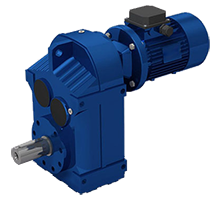The geared motor is a reducer type based on an AC or DC electric motor. The gear and motor are combined into one unit.
The geared motor provides high torque at low power or low speed. Gearmotors are most often used where, it takes more force to move heavy objects.
Basically, most industrial gearmotors use AC motors, however, DC motors can also be used as geared motors.
Gearmotors have a number of advantages over the engine and gearbox. Gearmotors can simplify the design and implementation by eliminating the step of individually designing and integrating motors with gears, which will reduce the cost of engineering work.
Another advantage of geared motors with the correct configuration is that the correct combination of the motor and gearbox can extend the life of the geared motor and ensure optimum power consumption.
In addition, since geared motors are integrated devices, they eliminate the need for couplings, and also eliminate any alignment problems. Such problems are common when a separate motor and gearbox are connected together and lead to an increase in the time and cost of maintenance, as well as to the bias potential that causes the bearing failure and, ultimately, a reduction in service life.
Advances in geared motors include the use of new special materials, coatings and bearings, as well as improved tooth designs that are optimized to reduce noise, increase strength and improve durability, thereby increasing productivity in small enclosures.
Although there are many different combinations of motor gearboxes, not everyone can go for different purposes. Some combinations are efficient and economical than others. Knowledge of the problem and the availability of precise parameters for the motor and gearbox is the basis for the successful integration of the geared motor into the system.
Our technical specialists are always happy to help you with the choice of geared motor
